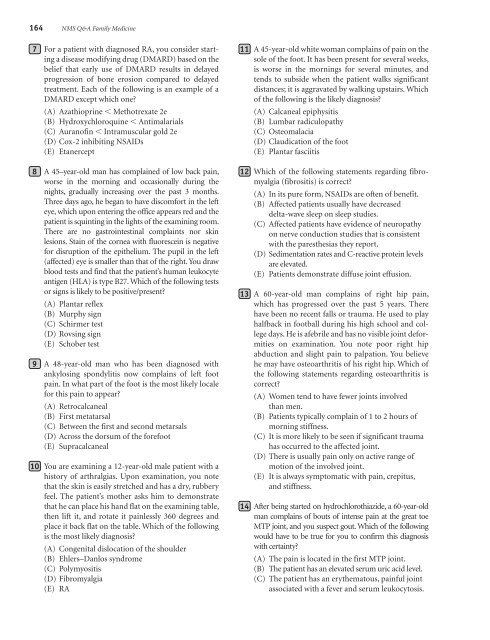NMS Q&A Family Medicine
NMS Q&A Family Medicine
NMS Q&A Family Medicine
- No tags were found...
You also want an ePaper? Increase the reach of your titles
YUMPU automatically turns print PDFs into web optimized ePapers that Google loves.
164 <strong>NMS</strong> Q&A <strong>Family</strong> <strong>Medicine</strong>7 For a patient with diagnosed RA, you consider startinga disease modifying drug (DMARD) based on thebelief that early use of DMARD results in delayedprogression of bone erosion compared to delayedtreatment. Each of the following is an example of aDMARD except which one?(A) Azathioprine Methotrexate 2e(B) Hydroxychloroquine Antimalarials(C) Auranofin Intramuscular gold 2e(D) Cox-2 inhibiting NSAIDs(E) Etanercept8 A 45–year-old man has complained of low back pain,worse in the morning and occasionally during thenights, gradually increasing over the past 3 months.Three days ago, he began to have discomfort in the lefteye, which upon entering the office appears red and thepatient is squinting in the lights of the examining room.There are no gastrointestinal complaints nor skinlesions. Stain of the cornea with fluorescein is negativefor disruption of the epithelium. The pupil in the left(affected) eye is smaller than that of the right. You drawblood tests and find that the patient’s human leukocyteantigen (HLA) is type B27. Which of the following testsor signs is likely to be positive/present?(A) Plantar reflex(B) Murphy sign(C) Schirmer test(D) Rovsing sign(E) Schober test9 A 48-year-old man who has been diagnosed withankylosing spondylitis now complains of left footpain. In what part of the foot is the most likely localefor this pain to appear?(A) Retrocalcaneal(B) First metatarsal(C) Between the first and second metarsals(D) Across the dorsum of the forefoot(E) Supracalcaneal10 You are examining a 12-year-old male patient with ahistory of arthralgias. Upon examination, you notethat the skin is easily stretched and has a dry, rubberyfeel. The patient’s mother asks him to demonstratethat he can place his hand flat on the examining table,then lift it, and rotate it painlessly 360 degrees andplace it back flat on the table. Which of the followingis the most likely diagnosis?(A) Congenital dislocation of the shoulder(B) Ehlers–Danlos syndrome(C) Polymyositis(D) Fibromyalgia(E) RA11 A 45-year-old white woman complains of pain on thesole of the foot. It has been present for several weeks,is worse in the mornings for several minutes, andtends to subside when the patient walks significantdistances; it is aggravated by walking upstairs. Whichof the following is the likely diagnosis?(A) Calcaneal epiphysitis(B) Lumbar radiculopathy(C) Osteomalacia(D) Claudication of the foot(E) Plantar fasciitis12 Which of the following statements regarding fibromyalgia(fibrositis) is correct?(A) In its pure form, NSAIDs are often of benefit.(B) Affected patients usually have decreaseddelta-wave sleep on sleep studies.(C) Affected patients have evidence of neuropathyon nerve conduction studies that is consistentwith the paresthesias they report.(D) Sedimentation rates and C-reactive protein levelsare elevated.(E) Patients demonstrate diffuse joint effusion.13 A 60-year-old man complains of right hip pain,which has progressed over the past 5 years. Therehave been no recent falls or trauma. He used to playhalfback in football during his high school and collegedays. He is afebrile and has no visible joint deformitieson examination. You note poor right hipabduction and slight pain to palpation. You believehe may have osteoarthritis of his right hip. Which ofthe following statements regarding osteoarthritis iscorrect?(A) Women tend to have fewer joints involvedthan men.(B) Patients typically complain of 1 to 2 hours ofmorning stiffness.(C) It is more likely to be seen if significant traumahas occurred to the affected joint.(D) There is usually pain only on active range ofmotion of the involved joint.(E) It is always symptomatic with pain, crepitus,and stiffness.14 After being started on hydrochlorothiazide, a 60-year-oldman complains of bouts of intense pain at the great toeMTP joint, and you suspect gout. Which of the followingwould have to be true for you to confirm this diagnosiswith certainty?(A) The pain is located in the first MTP joint.(B) The patient has an elevated serum uric acid level.(C) The patient has an erythematous, painful jointassociated with a fever and serum leukocytosis.
















